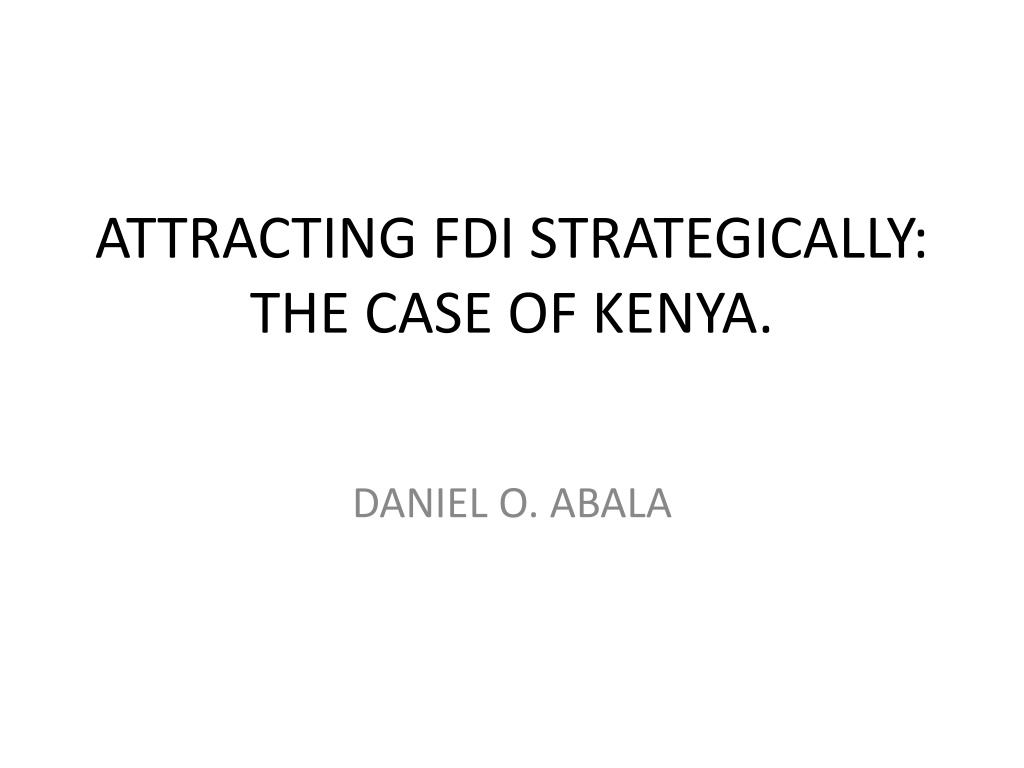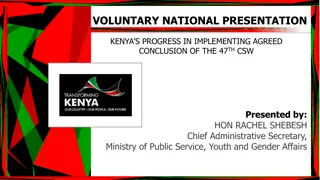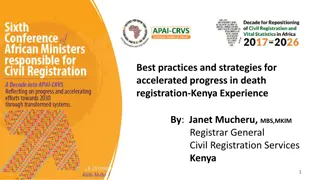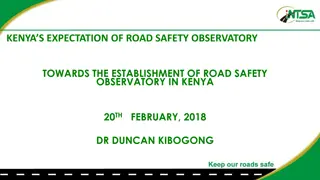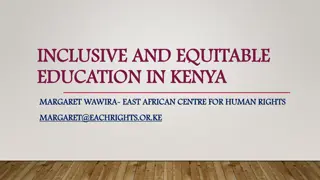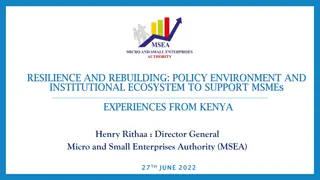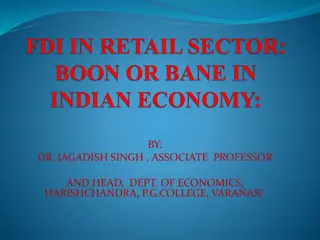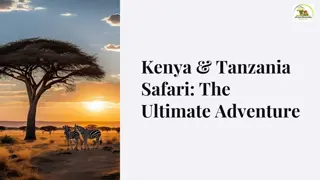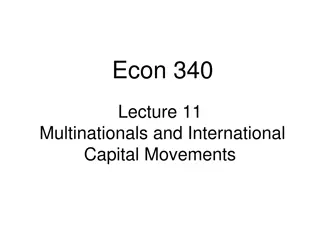Understanding FDI Trends in Kenya: A Strategic Analysis by Daniel O. Abala
Foreign Direct Investment (FDI) in Kenya has faced challenges despite being favorable in the past. This analysis delves into the evolution of FDI, the country's responses, policies, and the impact of corruption on attracting FDI inflows.
Download Presentation

Please find below an Image/Link to download the presentation.
The content on the website is provided AS IS for your information and personal use only. It may not be sold, licensed, or shared on other websites without obtaining consent from the author. Download presentation by click this link. If you encounter any issues during the download, it is possible that the publisher has removed the file from their server.
E N D
Presentation Transcript
ATTRACTING FDI STRATEGICALLY: THE CASE OF KENYA. DANIEL O. ABALA
OUTLINE Introduction Evolution of FDI s in Kenya Challenges to FDI Inflows into Kenya Kenya s strategic response to FDI Inflow challenges Kenya s FDI policies: Openness OR Restrictions Restrictions on FDI Business Facilitation Legal Regime Kenya s International posture Institutional framework: FDI laws and regulations Industrial policies impacting FDI Corruption and security environment
INTRODUCTION FDI is investment in foreign assets undertaken by a foreign national for purposes of production of goods and services which are to be sold either domestically or exported overseas (Investment Promotion Centre Act, Cap 518). FDIs are considered to be important in promoting economic growth in developing countries by providing domestic small and medium sized with linkages and markets for the supply of goods and services. Kenya s record in attracting FDIs has been poor despite having been the favoured destination in the 1960s, 70s and early 80s.
EVOLUTION OF FDIs IN KENYA Kenya has had along history with foreign firms. From independence through the 1970s and part of the 1980s it was one of the most favoured destinations in East Africa. The then relatively high level of and good infrastructure, market size, growth and openness to FDI at a time when other countries had relatively closed regimes. Kenya had relative political stability and security.
EVOLUTION OF FDIs IN KENYA contd FDI started a low of around US $ 10 million a year in early 1970s to peak at US$ 60 million in early 1980. The economy deteriorated in the 1980s along with corruption and bad governance. Inconsistency in economic policies and structural reform measures together with crumbling public services and infrastructure ensured decades of low levels of FDI inflows. Kenya has not recovered from this situation to date. FDI inflows in the period 1981-1999 averaged only US $22 million per annum.
EVOLUTION OF FDIs IN KENYA contd The relative FDI levels in 1970s and1980s were never high even by developing country standards. FDI stocks were only 7.5 % of the GDP in 2003 compared to 15.3% for Africa and 31.5% for developing countries (UNCTAD,2005). Kenya s regional supremacy in attracting FDI disappeared as soon as Tanzania and Uganda started reforming their economies and opening up to foreign investors in the early 1990s.
EVOLUTION OF FDIs IN KENYA contd FDI inflows in the period 1996-2003 averaged US $29 million while inflows to Tanzania and Uganda surged to US $280 million and US $220 million respectively from negligible levels in the 1980s. Considering Kenya's economic size relative to Tanzania and Uganda the situation is even worse. Kenya s share of FDI inflow stock among East African countries fell from 55% to 18% from mid 1990s to end of 2003. Between 2003 and 2009 the average FDI inflows to Kenya was US $ 106 million per annum compared to US $ 456 and US $ 521 million for Tanzania and Uganda respectively (world Bank, 2010).
EVOLUTION OF FDIs IN KENYA contd In the early part of this decade Kenya was attracting about a third of what each of her neighbours attracted in terms of FDI inflows. This situation persisted despite the Kenya government s attempts to implement a series of measures aimed at attracting foreign investors into Kenya. It has been clear that the factors behind Kenya s poor performance in attracting even at the time global surge in inflows (1996-2003) and particularly to its immediate with similar economic structures were to be found mainly within the country.
EVOLUTION OF FDIs IN KENYA contd Kenya s attractiveness to FDI continued to slump in the recent past to hit a six year low even as her East African neighbours increased their appeal to foreign capital. The fall in FDI inflows into Kenya has been persistent over the past five years to 2016 signalling the overall competitiveness of the region. East Africa received about US $ 7.1 billion in FDI IN 2016, about 13% increase from 2015, but this aggregate masks divergent FDI performance in the sub region.
EVOLUTION OF FDIs IN KENYA contd The decline in Kenya s FDI is despite the reforms that have created supportive domestic policy environment and in spite of the improved ease of doing business in Kenya as evidenced by the World Bank s ranking. The reality on the ground is that investment flows to other East African economies have continued to grow even as Kenya suffered a decline. FDI in Kenya remain relatively weak considering its economic size and the level of development. In recent years there has been light at the end of the tunnel.
EVOLUTION OF FDIs IN KENYA contd Kenya has become one of the largest recipients in Africa with inflows significantly increasing from about 2010. The rise has been mainly from Chinese investments in the mining and hydrocarbon sectors. According to UNCTAD 2018 World Report in 2017 the influx of FDI reached US $672 million which was a 70% increase year on year. The total FDI stock stood at US $ 11.9 billion representing about 15.9% of GDP. In the report, Kenya is ranked 4thhighest FDI recipient in East Africa after Ethiopia, Tanzania and Uganda.
Though Kenyas FDI inflow recorded a spectacular rebound to record US $ 672 million from 393 in 2016 it still trails other key Eastern Africa economies like Ethiopia with US $ 760 and Uganda with US$700 million. Kenya s inflow performance is attributed to buoyant domestic demand and inflows into the country s ICT sector.
CHALLENGES TO FDI INFLOWS INTO KENYA There has been a number of challenges identified by stakeholders who include key players in business, public sector and the country s development partners including international organisations. The challenges identified include; institutional framework, data and information, policy and regulatory framework, infrastructure, economic growth, cost of doing business, corruption and governance, human resources, security and political environment, low domestic investment .
KENYAS STRATEGIC RESPONSE TO FDI INFLOW CHALLENGES From 2010 Kenya has intensified reforms to address the challenges which constrained FDI inflows. Kenya generally has a positive investment climate that has made it attractive to international firms seeking a location for their regional or pan-African operations. Year-on-year the country continues to make improvements to its regulatory framework and improve its attractiveness as a destination for FDI. Kenya has a strong telecommunications infrastructure, robust financial sector, and extensive aviation connections within Africa and to Europe and Asia.
CONTd Mombasa port is the major trade gateway for much of East Africa. Kenya s membership in EAC and other regional trade blocs, provides growing access to larger regional markets. The World Bank Group s Doing business report for 2017 ranked Kenya as the third most reformed country as it moved up 21 places to 92 of the 190 economies reviewed on business regulatory reforms, following a similar move up in the rankings the previous year. This improvement was credited to reforms in starting a business, access to electricity, registering property, protecting minority investors, and resolving insolvency.
CONTd Some significant steps to improve foreign investments have also been taken these include the Bribery Act (2016) This mandates bribery prevention procedures, heightens penalties and imposes reporting obligations for private entities. Kenya now allows 100 percent foreign ownership of companies listed on Nairobi Stock Exchange. There has been continued progress by Kenya investment authority (KenInvest) and the Business Environment Delivery unit to reduce bureaucracy and simplify the business registration process.
CONTd The operationalization of the Mining Act (2016) points to a more positive investment climate for the extractive industries. There has also been progress on legislation to promote financial reform. These include financial services authority bill, Nairobi international financial centre bill and the movable property securities bill Kenya s macroeconomic fundamentals are among the strongest in Africa, with GDP growth rate at 5-6 percent, shrinking current account deficits improving infrastructure, and a strong consumer demand from a growing middle class. The medium-term economic outlook appears strong.
KENYA FDI POLICIES: OPENNESS OR RESTRICTIONS Kenya has developed a steadily improving environment for FDI. Foreign investors seeking to establish a presence in Kenya generally receive the same treatment as local investors, and MNCs make up a large percentage of Kenya s industrial sector. There is little discrimination against foreigners in accessing govt financed research and govt export promotion programs do not distinguish between goods produced by local and foreign owned firms.
CONTd Govt does not have a policy to steer investment to specific geographic locations but encourages investments in sectors that create employment, generate foreign exchange, and create forward and backward linkages with rural areas. To strengthen Kenya s manufacturing capacity, the government offers incentives for the production of goods for export. Keninvest, the official investment promotion agency, has developed a website to help investors navigate local regulations. There is also a database known as e-regulations giving investors and entrepreneurs full transparency on investment-related regulations and procedures in Kenya.
RESTRICTIONS ON FDI There are some limits and control on FDI but the govt has been making them as few as possible e.g. GOK repealed regulations in 2015 that had imposed a 75 % ownership limitation on firms listed on the Nairobi Securities Exchange allowing such firms to now be 100% foreign owned. A clause in the companies Act (2015) had imposed local content requirement but has now been repealed after complaints from WTO. The Communications Authority requires 20% Kenyan shareholding within three years of receiving a license.
CONTd The new Mining Act (2016) restricts foreign participation in the mining sector. Among other restrictions, it reserves the acquisition of mineral rights to Kenyan companies, and requires 60% Kenyan ownership of mineral dealerships and artisanal mining companies. The Private Security Regulations Act (2016) restricts foreign participation in the private security sector by requiring that at least 25% of shares in those firms be held by Kenyans.
CONTd The National Construction Authority Act (2011) imposes local content restrictions on foreign contractors", defined as companies incorporated outside Kenya or with more than 50% ownership by non-Kenyan citizens. The Act requires foreign contactors to enter into subcontracts or joint ventures assuring that at least 30% of the contract work is done by local firms. The Kenya Insurance Act (2010) restricts foreign capital investment to two thirds with no single person controlling more than 25% of an insurers capital.
BUSINESS FACILITATION In terms of business facilitation the business registration services (BRS) Act (2015) and the Companies Act (2015) aim to strengthen Kenya s position as a destination for investors. The BRS seeks to establish a state corporation-the Business Registration Service to ensure effective administration of the laws relating to the registration, operation and management of companies, partnerships and firms. The Companies Act (2015) deals with specifics of registration and management as they pertain to public and private corporations.
CONTd A Business Environment Delivery Unit was established in 2014 to address challenges facing investors in the country - it focuses on reducing the bureaucratic steps related to setting up and doing business in the country. It operates a website offering online information on relevant requirements, costs, application and contact details for the relevant regulatory agency. An investment guide designed with the help of UNCTAD and the International Chamber of Commerce provide investors with up-to-date information on business costs, licensing requirement, opportunities and conditions in developing countries.
CONTD Kenya is a member of UNCTAD s international network of transparent procedures. Bilateral investment agreement and Taxation treaties-AGOA-Trade preference and export promotion policy. GOK has trade facilitation (TFA) through WTO, EAC , COMESA and EU-EAC economic partnership agreement.
LEGAL REGIME Kenya s regulatory system is relatively transparent and continues to improve. Kenya s business registration and licensing systems are fully digitized and transparent and computerization of other govt processes to increase transparency and close avenues for corruption are ongoing. A few issues such as issuance of work permits seem to be in disarray with overlapping and sometimes contradictory regulations. There may be need to amend some laws to streamline this.
KENYAS INTERNATIONAL POSTURE Kenya is a member of EAC and generally applies EAC policies on trade and investment. Kenya is also a member of COMESA and IGAD where it is considered to have strong performance on regional trade issues. Kenya generally adheres to international regulatory standards.
INSTITUTIONAL FRAMEWORK: FDI LAWS AND REGULATIONS Kenya s 2010 constitution established an independent judiciary. There is no systematic executive or other interference in the court system that affects foreign investors. However, the courts are plagued by frequent allegations of corruption and long delays in rendering judgements. The major regulations governing FDI is the Investment Promotion Act (2004).
CONTd Other important documents providing a framework for FDI include the 2010 Constitution of Kenya, the Companies Ordinance, the Private Public Partnership Act(2013), the Foreign Investment Protection Act (1990), and the Companies Act (2015). Competition and Anti-Trust laws The 2010 Constitution guarantees safety from expropriation except for security concerns. There are various levels of dispute settlement including arbitration. The Insolvency Act(2015) modernised the legal framework for bankruptcies.
INDUSTRIAL POLICIES IMPACTING FDI These have been in the form of incentives through tax law, MUB for manufacturing firms. MUB started in 1986 is meant to encourage manufacturing for export. It provides a 100% tax deduction on plant and equipment and imports for export goods production. Export processing Zones, SEZs offer special incentives for firms operating within them. Minimum foreign investment to qualify for GOK investment incentives is $100000 seen as a deterrent to foreign small and medium enterprise investment.
Foreigners cannot own land in Kenya, though they can lease it in 99 year increments. Property rights are guaranteed in the 2010 constitution.
CORRUPTION AND SECURITY ENVIRONMENT Corruption in Kenya is pervasive and entrenched. It is an impediment to FDI Kenya has enacted a variety of laws to fight the vice but so far there has been little progress. These include Anti-Corruption and Economic Crimes Act (2003), the Public Officers Ethics Act (2003), the code of Ethics Act for Public Servants (2004), the public procurement and Disposal Act (2010), the Leadership and Integrity Act(2012) and the Bribery Act (2016).
CONTd Peace and security is a prerequisite for FDI Inflows and this has been a challenge considering frequent terrorist attacks. There has been negative perception abroad due to election related violence and overall insecurity. Regional conflict, most notably in Somalia and South Sudan sometimes have spill-over effects in Kenya with increase in refugees escaping drought and instability in neighbouring countries.
